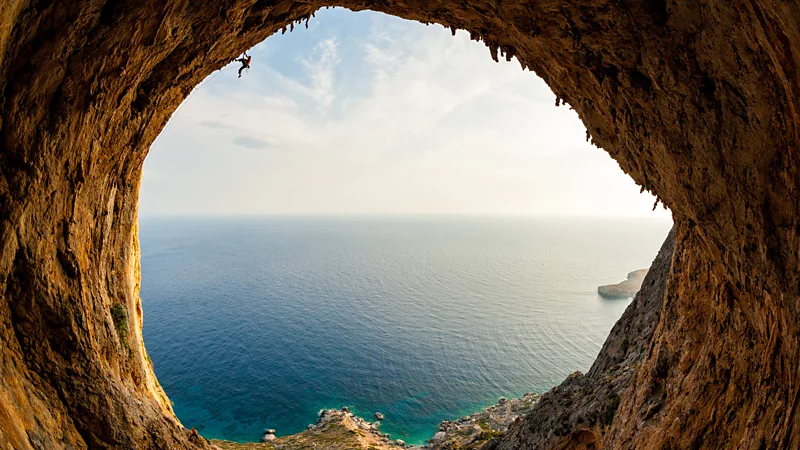
Five of the World’s Most Beautiful Climbing Locations
From Tasmania to Vietnam, the world is filled with incredible rock formations that draw in adventurous climbers. Australian climber and photographer Simon Carter shares his top five picks for the best places to challenge yourself and enjoy nature’s wild beauty.
You may have seen Tom Cruise scaling the red rocks of Utah’s Dead Horse Point in Mission: Impossible II or Alex Honnold’s mind-blowing, rope-free ascent of El Capitan in the Oscar-winning documentary Free Solo. These films have sparked a global climbing boom. “Over the last 20 years, I’ve seen more and more people getting into outdoor climbing,” says Simon Carter. Films, climbing gyms, and sport climbing’s inclusion in the 2020 Olympics in Japan have all contributed to the sport’s growing popularity.
Simon Carter, who has been climbing for 40 years, is known for his stunning climbing photography. His work takes him to the best climbing spots worldwide, which he has captured in his book The Art of Climbing. What draws him to climbing isn’t just the physical and mental challenge but also the chance to experience incredible places and meet interesting people. “You get to visit spots that are so fascinating and remote—places you’d never see as a regular tourist. The connection to nature is one of the most powerful things about climbing,” he says.
Here are five of Carter’s favourite climbing locations around the world, where climbers can push their limits and experience the beauty of rugged landscapes.
Tasman Peninsula Pillars, Australia

The Tasman Peninsula in southeast Tasmania is home to some of the world’s most dramatic sea cliffs. Known for its towering sea columns of Jurassic dolerite, the peninsula feels like the edge of the world. Port Arthur, a famous convict colony, is nearby, but climbers are drawn to the rugged coastline.
The Tasman Peninsula is home to three iconic sea pillars: The Totem Pole, The Moai, and the Pole Dancer. These towering rock formations offer thrilling challenges for experienced climbers. Carter explains, “The Totem Pole is 65 meters high, and it’s like a matchstick jutting out of the ocean. It’s a technical climb in a mind-blowing location.”
Reaching these sea pillars requires effort—hiking, abseiling, and multiple climbing pitches. Climbers can get to Tasmania via flights from major Australian cities or by ferry. Having a car makes it easier to access remote areas.
Kalymnos and Telendos, Greece

While islands like Crete and Mykonos are famous for their beaches and tourist attractions, Kalymnos is legendary in the climbing world. This rocky island between Kos and Leros in the Dodecanese chain offers over 4,000 climbing routes on limestone crags scattered across both Kalymnos and the neighbouring island, Telendos.
“Kalymnos is a paradise for climbers,” says Carter. “It’s probably the most popular rock climbing destination in the world right now.” The island has something for everyone, from easy climbs to incredibly challenging routes. One of the most remarkable experiences is Crystal Cave on Telendos, which can be reached by a short ferry ride. This technical endurance climb requires strength and a long rope to descend from the top. “It’s an extraordinary place,” Carter says.
Flights from Athens or ferries from nearby islands make Kalymnos accessible, and it’s a must-visit for climbers seeking adventure in the Mediterranean.
Smith Rock State Park, USA
Smith Rock State Park in Oregon is where modern American sport climbing was born. In the 1960s and 1970s, climbers began to explore the steep, clean walls that lacked cracks for traditional climbing gear. They started placing permanent safety bolts, which led to the rise of sport climbing—focusing on physical and gymnastic skills.
Smith Rock, with its striking orange rock formations and the Crooked River running through it, is a climbing oasis in the high desert of central Oregon. “It has a Wild West feel to it,” says Carter. The park features over 2,000 climbing routes, ranging from easy climbs to challenging classics like To Bolt Or Not To Be, a 41-meter-high wall that remains a coveted test for top climbers.
Smith Rock is about a 200-mile drive from Portland, making it a beautiful yet accessible destination for climbers of all skill levels.
Les Calanques, France

On France’s southern coast near Marseille, the Calanques National Park offers some of the most picturesque climbing in the world. This area has a long history in the climbing community. French mountaineers came here in the early 1900s to practice their skills when the weather was bad in the mountains.
The park is famous for its limestone cliffs overlooking the Mediterranean Sea, with routes suitable for all skill levels. Climbers can choose from classic traditional routes or modern sport climbs on overhangs and caves. The proximity to beaches adds to the magic of the place. “You’re climbing above the beautiful, sparkling Mediterranean. It’s really special,” Carter says.
Marseille is a convenient base, or climbers can stay in smaller port towns like Les Goudes. Whether you’re looking for easy climbs or something more challenging, Les Calanques offers unforgettable experiences.
Hạ Long Bay, Vietnam
Hạ Long Bay, a UNESCO World Heritage Site in northeastern Vietnam, is known for its breathtaking beauty, with over 2,000 limestone karsts rising out of the emerald waters. While many visitors explore the bay by boat, it’s also a paradise for rock climbers.
Cát Bà, the largest island in the bay, is a hub for climbers, with popular cliffs like Butterfly Wall. However, the best climbing experiences are found by boat, where climbers can discover remote limestone formations. “Hạ Long Bay is an extraordinary place,” says Carter. “You could get lost exploring its climbing opportunities for days.”
One unique experience here is deep-water soloing, where climbers scale walls without ropes, relying on the ocean as a crash pad. Turtle Cave is a prime example, where climbers aim to reach the lip of the cave 10 meters above the water without any safety gear.
While Hạ Long Bay’s climbs are best suited for experienced climbers, the stunning scenery and thrilling challenges make it a must-visit destination for adventurous souls.






